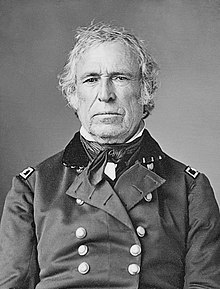|
United States of America
Zachary Taylor – Twelfth President
1970 Proof Silver Medal 39mm (33.03 grams) 0.925 Silver
ZACHARY TAYLOR 1849 TWELFTH PRESIDENT OF THE UNITED STATES 1850, Zachary facing.
ZACHARY TAYLOR BORN NOV. 24, 1784. MARRIED MARGARET SMITH, 1810. CALLED “OLD ROUFGHT AND READY”; HERO OF MEXICAN WAR; FIRST CAREER SOLD-IER ELECTED PRESDIENT. A SOUTHERNER WHO OPPOSED SECESSION. DIED JULY 9, 1850., Eagle with arrows in claws right atop American shield with stripes and stars.
You are bidding on the exact item pictured, provided with a Certificate of Authenticity and Lifetime Guarantee of Authenticity.

Zachary Taylor (November 24, 1784 – July 9, 1850) was an American military leader who served as the 12th president of the United States from 1849 until his death in 1850. Taylor previously was a career officer in the United States Army, rising to the rank of major general and becoming a national hero as a result of his victories in the Mexican–American War. As a result, he won election to the White House despite his vague political beliefs. His top priority as president was preserving the Union. He died sixteen months into his term, having made no progress on the most divisive issue in Congress, slavery.
Taylor was born into a prominent family of plantation owners who moved westward from Virginia to Louisville, Kentucky, in his youth; he was the last president born before the adoption of the Constitution. He was commissioned as an officer in the U.S. Army in 1808 and made a name for himself as a captain in the War of 1812. He climbed the ranks of the military, establishing military forts along the Mississippi River and entering the Black Hawk War as a colonel in 1832. His success in the Second Seminole War attracted national attention and earned him the nickname “Old Rough and Ready”.
In 1845, during the annexation of Texas, President James K. Polk dispatched Taylor to the Rio Grande in anticipation of a battle with Mexico over the disputed Texas–Mexico border. The Mexican–American War broke out in April 1846, and Taylor defeated Mexican troops commanded by General Mariano Arista at the battles of Palo Alto and Resaca de la Palma, driving Arista’s troops out of Texas. Taylor then led his troops into Mexico, where they defeated Mexican troops commanded by Pedro de Ampudia at the Battle of Monterrey. Defying orders, Taylor led his troops further south and, despite being severely outnumbered, dealt a crushing blow to Mexican forces under General Antonio López de Santa Anna at the Battle of Buena Vista. Taylor’s troops were subsequently transferred to the command of Major General Winfield Scott, but Taylor retained his popularity.
The Whig Party convinced a reluctant Taylor to lead their ticket in the 1848 presidential election, despite his unclear political tenets and lack of interest in politics. At the 1848 Whig National Convention, Taylor defeated Winfield Scott and former Senator Henry Clay for the party’s nomination. He won the general election alongside New York politician Millard Fillmore, defeating Democratic Party candidates Lewis Cass and William Orlando Butler, as well as a third-party effort led by former president Martin Van Buren and Charles Francis Adams, Sr. of the Free Soil Party. Taylor became the first president to be elected without having served in a prior political office. As president, Taylor kept his distance from Congress and his Cabinet, even though partisan tensions threatened to divide the Union. Debate over the status of slavery in the Mexican Cession dominated the national political agenda and led to threats of secession from Southerners. Despite being a Southerner and a slaveholder himself, Taylor did not push for the expansion of slavery, and sought sectional harmony above all other concerns. To avoid the issue of slavery, he urged settlers in New Mexico and California to bypass the territorial stage and draft constitutions for statehood, setting the stage for the Compromise of 1850.
Taylor died suddenly of a stomach disease on July 9, 1850, with his administration having accomplished little aside from the ratification of the Clayton–Bulwer Treaty. Vice President Fillmore assumed the presidency and served the remainder of his term. Historians and scholars have ranked Taylor in the bottom quartile of U.S. presidents, owing in part to his short term of office (16 months), though he has been described as “more a forgettable president than a failed one”.
|











